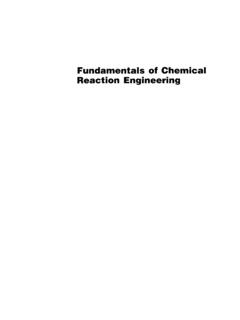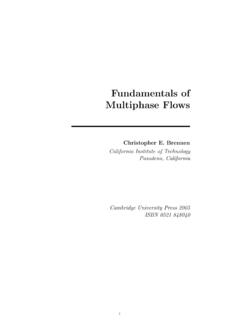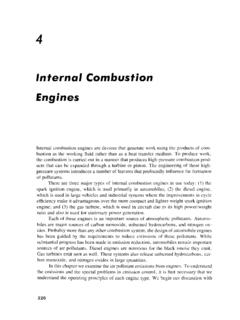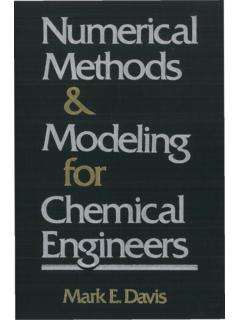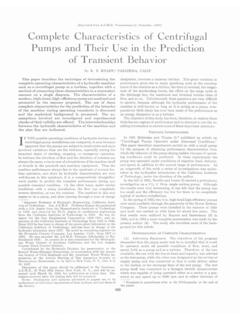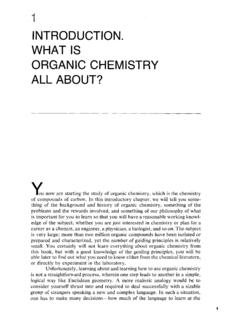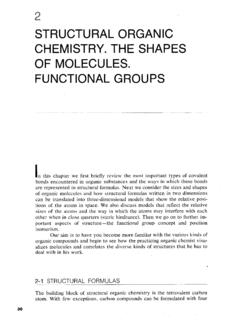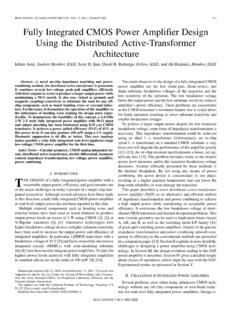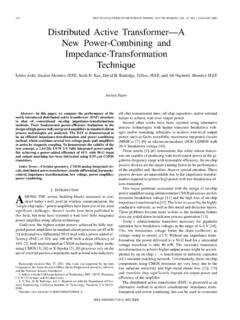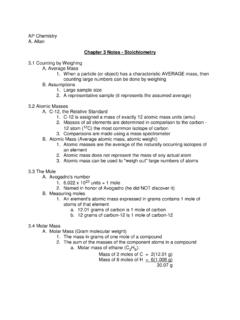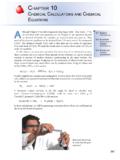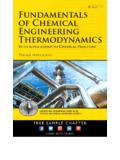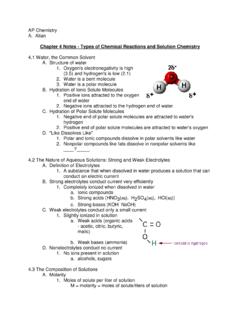Transcription of Combustion Fundamentals - CaltechAUTHORS
1 2. Combustion Fundamentals To understand the fonnation of pollutants in Combustion systems, we must first under- stand the nature of the fuels being burned, the thennodynamics of the Combustion pro- cess, and some aspects of flame structure. In this chapter we discuss fundamental aspects of hydrocarbon fuel Combustion that relate directly to the fonnation of pollutants or to the control of emissions. Questions of flame stability, detonations, and several other important aspects of Combustion science are beyond the scope of the present discussion and will not be treated. Specific pollution control problems will be addressed in detail in later chapters. FUELS. Of the spectrum of fuels currently in widespread use, the simplest in composition is natural gas, which consists primarily of methane but includes a number of other con- stituents as well.
2 The compositions of other gaseous fuels are generally more complex, but they are, at least, readily detennined. Table illustrates the range of compositions encountered in gaseous fuels, both natural and synthetic. Infonnation on the composition of liquid or solid fuels is generally much more limited than that for gaseous fuels. Rarely is the molecular composition known since liquid fuels are usually complex mixtures of a large number of hydrocarbon species. The most commonly reported composition data are derived from the ultimate analysis, which consists of measurements of the elemental composition of the fuel, generally presented as mass fractions of carbon, hydrogen, sulfur, oxygen, nitrogen, and ash, where appro- 59.
3 En o TABLE PROPERTIES OF GASEOUS FUELS. Heating Other value". CH 4 C 2 H6 C 3 Hs hydrocarbons CO H2 H2 S N2 CO 2 (106 Jm- 3 ). Natural gas No. 1 b 0 Refinery gas No. 1 No. 3 Coke oven gas Blast furnace gas 13 "p, 101 kPa; T, 25 C. b"Sweetened," H2S removed. Sec. Fuels 61. TABLE PROPERTIES OF TYPICAL LIQUID FUELS. Percent by weight Heating Specific value Gasoline C H N 0 S Ash gravity (106 J kg-I). Kerosene (No. 1) Trace Fuel oil Trace <2 < priate. The heating value, a measure of the heat release during complete Combustion , is also reported with the ultimate analysis. Ultimate analyses of a number of liquid fuels are presented in Table In addition to the limited composition data given in Tables and , physical properties that influence the handling and use of a particular fuel are frequently mea- sured.
4 For liquid fuels, the specific gravity or API gravity, * viscosity (possibly at several temperatures), flash point (a measure of the temperature at which the fuel is sufficiently volatile to ignite readily), and distillation profiles (fraction vaporized as a function of temperature) may be reported. The properties of solid fuels vary even more widely than those of liquid fuels. The most common solid fuel is coal. Formed by biological decomposition and geological transformation of plant debris, coals are classified by rank, a measure of the degree to which the organic matter has been transformed from cellulose. Low-rank fuels such as peat or lignite have undergone relatively little change, whereas high-rank anthracite is nearly graphitic in structure.
5 Low-rank fuels contain large amounts of volatile matter that are released upon heating. High-rank fuels contain much more fixed carbon, which remains after the volatiles are released. Solid fuels are characterized by the ultimate analysis and by the so-called proxi- mate analysis, which identifies the degree of coalifaction of a solid fuel (Table ). Coal samples that have been air dried are subjected to a number of standardized tests to determine the amount of moisture inherent to the coal structure, the quantity of volatile matter released by the coal upon heating to 1200 K for several minutes, and the mass of ash or noncombustible inorganic (mineral) impurities that remains after low temper- ature (700 to 1050 K) oxidation.
6 The difference between the initial mass of coal and the sum of masses of moisture, volatile matter, and ash is called fixed carbon. The condi- tions of these standardized tests differ markedly from typical Combustion environments, and the values reported in the proximate analysis do not necessarily represent yields actually encountered in practical combustors. This point is discussed in more detail in the section on solid fuel Combustion . *Degrees API = [ (specific gravity 16 Cjwater at 16 C) - ]. Ol N. TABLE PROPERTIES OF SELECTED SOLID FUELS. Percent by weight Proximate analysis Ultimate analysis Heating Volatile value Fuel (state) Carbon matter Moisture Ash C H N 0 S (106 J kg-I). Meta-anthracite (RI) Anthracite (PA) Semianthracite (PA) Bituminous (PA) High-volatile bituminous (PA) (CO) (KY) (IL) Subbituminous (CO) Lignite (ND) Brown coal (Australia) Wood (Douglas fir, as received) 0 Sec.
7 Combustion stoichiometry 63. Combustion stoichiometry . Complete oxidation of simple hydrocarbon fuels forms carbon dioxide (C0 2 ) from all of the carbon and water (H20) from the hydrogen, that is, for a hydrocarbon fuel with the general composition CnH m, Even in the idealized case of complete Combustion , the accounting of all species present in Combustion exhaust involves more than simply measuring the CO2 and H20. Since fuels are burned in air rather than in pure oxygen, the nitrogen in the air may participate in the Combustion process to produce nitrogen oxides. Also, many fuels contain elements other than carbon, and these elements may be transformed during Combustion . Finally, Combustion is not always complete, and the effluent gases contain unburned and partially burned products in addition to CO 2 and H 2 0.
8 Air is composed of oxygen, nitrogen, and small amounts of carbon dioxide, argon, and other trace species. Since the vast majority of the diluent in air is nitrogen, for our purposes it is perfectly reasonable to consider air as a mixture of (mole basis) O2. and % (mole basis) N2 Thus for every mole of oxygen required for Combustion , mol of nitrogen must be introduced as well. Although nitrogen may not significantly alter the oxygen balance, it does have a major impact on the thermodynamics, chemical kinetics, and formation of pollutants in Combustion systems. For this reason it is useful to carry the "inert" species along in the Combustion calculations. The stoichiometric relation for complete oxidation of a hydrocarbon fuel, CnH m, becomes Thus for every mole of fuel burned, 4.
9 78( n + m 14) mol of air are required and 4. 78( n + m 14) + m 14 mol of Combustion products are generated. The molar fuel/air ratio for stoichiometric Combustion is 1 I [4. 78( n + m 14) ]. Gas compositions are generally reported in terms of mole fractions since the mole fraction does not vary with temperature or pressure as does the concentration (moles/. unit volume). The product mole fractions for complete Combustion of this hydrocarbon fuel are n Yeo2 = (n + m14) + ml4. ml2. YH20 = (n + m14) + ml4. ( n + m 14). YN2 = (n + m14) + ml4. 64 Combustion Fundamentals Chap. 2. The large quantity of nitrogen diluent substantially reduces the mole fractions of the Combustion products from the values they would have in its absence.
10 Example Combustion of Octane in Air Detennine the stoichiometric fuel/air mass ratio and product gas composition for combus- tion of octane (C SH 1S ) in air. The overall stoichiometry is C SH 1S + (Oz + ) ----+- 8CO z + 9H zO + For each mole of fuel burned, mol of air is required. The molecular weight of octane is 114. The fuel/air mass ratio for stoichiometric Combustion is, therefore, 114 = 114 = (32 + x 28) 1723. The total number of moles of Combustion products generated is 8 + 9 + = Finally, the product gas composition is, on a mole fraction basis, 8. Yeo, = - - = = 9. YH,O = --5 = = = = = YN, Minor components and impurities in the fuel complicate our analysis of combus- tion products somewhat.
